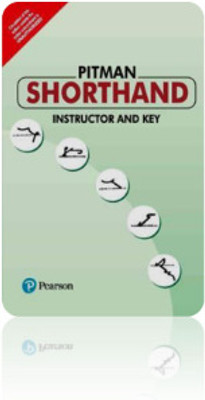Shorthand Key Pitman (Pocket)(Paperback, Issac Pitman)
Quick Overview
Product Price Comparison
P HONOGRAPHY, the name originally given to Pitman Shorthand, has been briefly but accurately defined as "the art of representing spoken sounds by character; a system of shorthand." The first question that will occur to the student will be, what is the fundamental difference between the shortnand characters and the letters in ordinary writing and print- ing? To answer this question it is necessary to consider the alphabet of the language, It is obvious that the usual or Romanic alphabet of twenty-six letters cannot represent by distinct characters the thirty-six typical sounds of the English language. As a consequence, many of the letters of that alphabet are of necessity used to represent different sounds. It is manifest, therefore, that any system of shorthand founded on the common alphabet would prove a very imperfect and cumbrous instrument for recording spoken utterances with cer- tainty and speed-the chief object of shorthand. With such an alphabet either a single sign standing for one of the letters would be required to do duty for several sounds, or more than one character would have to be used to represent a single sound, as is done in ordinary spelling. On the other hand, the three consonants C, Q and X are unnecessary, inasmuch as they represent sounds provided for by other consonants. Two simple illustrations will demonstrate the difference between the ordinary spelling and the phonetic method, which is the distinctive feature of Pitman Shorthand.The first illustration deals with consonants, and is concerned with the ordinary spelling of the words gaol and gale, in which the sounds of the first consonant are different, although represented in longhand by the same letter. If the common spelling were followed in shorthand, we should have the same shorthand symbol for both words. But the initial sounds in these words are different; in the first the sound is jay, in the second g For these dissimilar sounds the Pitman system provide dissimilar shorthand signs. The second illustration gay. deals with vowels, as, for example, in the words tub tube. If the shorthand symbols were the equivalents the letters of the common alphabet (the final e of tube being omitted because it is not sounded), the stens grapher would be obliged to write both words precisely the same characters, namely, t-u-b. Pitman Shorthand, however, provides for the representation of the different sounds and a heard in the respective words, and these are indicated by different symbols. byThe phonetic notation of the system of shorthand developed in the present work has been found, after widely extended use, to possess important practical advantages. By the employment of the phonetic alphabet, which has been termed the "alphabet of nature," spoken language can be recorded with one- sixth of the trouble and time that longhand requires, by those who use Pitman Shorthand simply as a substitute for the ordinary longhand writing. With the adoption of the systematized methods of abbreviation developed in the more advanced stages, this method of shorthand can be written legibly with the speed of the most rapid distinct articulation, and it may be read with the certainty and ease of ordinary longhand writing.An explanation on one point, however, is desirable. In the study and use of Pitman Shorthand it should be borne in mind that although the system is phonetic it is not designed to represent or record minute shades of pronunciation. The Pitmanic alphabet, in the words of Max-Muller, "comprehends the thirty-six broad typical sounds of the English language and assigns to each a definite sign." It does not seek to mark, for example, the thirty or more variations of sound which have been found to exist in the utterance of the twelve simple vowels. The pronunciation of the vowels, as Max-Muller has shown, varies greatly in different localities and in the various countries of the world in which the English language is spoken, and in which Pitman Shorthand is practised. The standard of pronunciation, as exhibited in printed shorthand, cannot, therefore, be expected to coincide minutely with the pronunciation of English in all parts. Experience has abundantly proved that the representation of the broad typical sounds of English as provided for in Pitman Shorthand is ample for all stenographic purposes.The presence of r has a modifying effect upon a preceding vowel. The student's attention is, therefore, directed to the following observations with regard to the consonant r, to certain vowels when preceding r and to a class of vowels which may be described as more or less obscure.(a) With the exception of worsted (the woollen material) and a few proper names, as Worcester, wherever the consonant r occurs in a word, in Pitman Shorthand it must be represented as a consona


